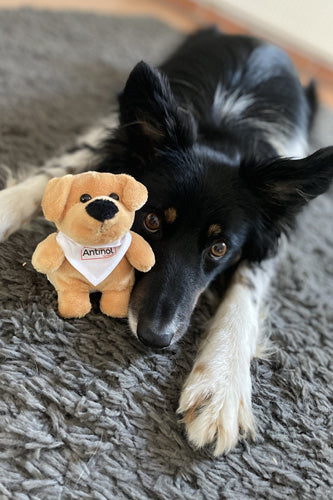It's easy to forget how old your pooch is. They're a family member—maybe they've been with you forever, but it doesn't feel like it.
They still zoom after their ball, bark at the doorbell, and bounce on the spot at dinnertime.
But have you noticed they’re slowing down? Maybe they're stiff after their walk, or they’re refusing to get into the car.
It's time to consider supporting your furry friend in their senior years. Check out our top tips make your home senior dog friendly.
How old is my dog in human years?
But first, how old is old? Let’s compare your dog with humans. Traditionally you calculated this by multiplying your dog's actual age by 7, but now we understand ageing a little better, it's more complicated.
The easiest way to check your dog's human age is using a calculator. This one from Science magazine uses DNA evidence to calculate your dog's human age.
So how old are they? Vetz Petz office pooch Bella, is 71, with Rosie not far behind at 69.
Signs your dog needs mobility support
Every dog is different when it comes to showing signs that they need extra support – they're very clever at hiding their problems, but here are a few things to look out for.
- Struggling to rise from resting
- Favouring one leg over another
- Nodding their head as they walk
- Losing their get-up-and-go and resting lots
- Reluctance to climb stairs, jump into the car, or onto the sofa
- Overgrooming certain areas, or the opposite, not keeping themselves tidy
- Mood swings—being reactive or grumpy
How to help your senior dog with their mobility
There are lots of easy things you can do to support your senior dog and help them feel more comfortable at home.
Take shorter dog walks

Even as your dog ages, they'll still need to get out and about. In fact, unless your vet recommends complete rest, keeping your dog mobile is great for their health and mobility. But consider reducing the length or intensity of dog walks, don’t go for long weekend walks compared to weekdays, and lose that ball thrower!
See a veterinary rehabilitation professional
Physical therapy can improve your dog's mobility. A veterinary rehabilitation specialist may offer a variety of treatments, massage, or give your dog some stretches and exercises to do at home that could improve their range of motion and help to keep them comfortable.
If you're not sure what will happen at a rehabilitation appointment, learn what to expect here.
Joint supplements for dogs
A joint supplement will support your dog's joint health from the inside. Make sure you choose a supplement that is clinically proven and safe for long-term use.
5 simple ways to adapt your home + support your senior dog’s joint health
No doubt, you’ve already spoken to your vet and have a plan of action to support your dog, but there are also things you can do in your home to make life easier for your furry friend.
1. Cover slippery floors
Laminate, vinyl, or tile floors look lovely and are super easy to clean up muddy paw prints, or sweep up shed fur, but they make life difficult for our older pooches. Sliding around on floors risks injury and can be distressing for dogs as they struggle to balance.
Lay rugs or yoga mats in areas that your dog struggles with the most. You could also try paw pads to increase their grip, or paw wax which you apply to their pads.
Keeping the hair trimmed between their toes, and their claws clipped also increases their grip.
2. Avoid the stairs
Going up and down stairs puts a lot of strain on your dog's joints. Add a baby gate to the bottom to stop them sneaking up to the bedrooms.
If your pooch sleeps upstairs, you can help them up the stairs by carefully carrying them, or investing in a specialised non-slip ramp.
3. Dinner with a view
A simple way to relieve pressure on your dogs joints, is with a raised dog bowl. There are lots of designs to choose from. You could even raise their water bowl too. The shift in posture is particularly useful for dogs who need to take pressure off of their neck, back and front legs.
4. VIP travel
If your dog is reluctant to get into the car, grab a car ramp and let your dog travel in style. These are light-weight and adjust to fit your car, giving a non-slip surface with no joint-jolting jumps up or down.
5. A comfy spot to snooze

Keep your senior dog comfortable with a supportive bed. There are plenty of orthopaedic and memory foam options that take the strain off of your dog's aching body. Look for one that is insulated from the cold floor or slightly raised to make getting up and down that little bit easier.
We hope these tips help your senior dog to feel more comfortable at home. We’d love to hear which ones work best for your dog.









